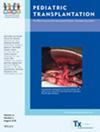Pathology of explanted pediatric hearts: An 11‐year study. Population characteristics and implications for outcomes
IF 1.2
4区 医学
Q3 PEDIATRICS
引用次数: 0
Abstract
BackgroundAs more pediatric patients become candidates for heart transplantation (HT), understanding pathological predictors of outcome and the accuracy of the pretransplantation evaluation are important to optimize utilization of scarce donor organs and improve outcomes. The authors aimed to investigate explanted heart specimens to identify pathologic predictors that may affect cardiac allograft survival after HT.MethodsExplanted pediatric hearts obtained over an 11‐year period were analyzed to understand the patient demographics, indications for transplant, and the clinical–pathological factors.ResultsIn this study, 149 explanted hearts, 46% congenital heart defects (CHD), were studied. CHD patients were younger and mean pulmonary artery pressure and resistance were significantly lower than in cardiomyopathy patients. Twenty‐one died or underwent retransplantation (14.1%). Survival was significantly higher in the cardiomyopathy group at all follow‐up intervals. There were more deaths and the 1‐, 5‐ and 7‐year survival was lower in patients ≤10 years of age at HT. Early rejection was significantly higher in CHD patients exposed to homograft tissue, but not late rejection. Mortality/retransplantation rate was significantly higher and allograft survival lower in CHD hearts with excessive fibrosis of one or both ventricles. Anatomic diagnosis at pathologic examination differed from the clinical diagnosis in eight cases.ConclusionsSurvival was better for the cardiomyopathy group and patients >10 years at HT. Prior homograft use was associated with a higher prevalence of early rejection. Ventricular fibrosis (of explant) was a strong predictor of outcome in the CHD group. We presented several pathologic findings in explanted pediatric hearts.被取出的小儿心脏的病理学:为期 11 年的研究。人群特征及对结果的影响
背景随着越来越多的儿科患者成为心脏移植(HT)的候选者,了解移植结果的病理预测因素和移植前评估的准确性对于优化稀缺供体器官的利用和改善移植结果非常重要。作者旨在对移植的心脏标本进行调查,以确定可能影响心脏移植后心脏同种异体存活率的病理预测因素。方法对11年间获得的移植小儿心脏进行分析,以了解患者的人口统计学特征、移植适应症以及临床病理因素。CHD患者更年轻,平均肺动脉压力和阻力明显低于心肌病患者。21例患者死亡或接受了再次移植(14.1%)。在所有随访间隔中,心肌病组的存活率都明显较高。HT 年龄小于 10 岁的患者死亡人数较多,1 年、5 年和 7 年存活率较低。暴露于同种移植组织的心脏病患者早期排斥反应明显较高,但晚期排斥反应不明显。在单侧或双侧心室过度纤维化的CHD心脏中,死亡率/再移植率明显较高,异体移植存活率较低。病理检查的解剖诊断与临床诊断不同的病例有8例。结论心肌病组和使用同种异体移植物10年的患者存活率更高。既往使用过同种异体移植与早期排斥反应发生率较高有关。心室纤维化(移植体)是预测心肌病组预后的一个重要因素。我们介绍了移植小儿心脏的几种病理结果。
本文章由计算机程序翻译,如有差异,请以英文原文为准。
求助全文
约1分钟内获得全文
求助全文
来源期刊

Pediatric Transplantation
医学-小儿科
CiteScore
2.90
自引率
15.40%
发文量
216
审稿时长
3-8 weeks
期刊介绍:
The aim of Pediatric Transplantation is to publish original articles of the highest quality on clinical experience and basic research in transplantation of tissues and solid organs in infants, children and adolescents. The journal seeks to disseminate the latest information widely to all individuals involved in kidney, liver, heart, lung, intestine and stem cell (bone-marrow) transplantation. In addition, the journal publishes focused reviews on topics relevant to pediatric transplantation as well as timely editorial comment on controversial issues.
 求助内容:
求助内容: 应助结果提醒方式:
应助结果提醒方式:


